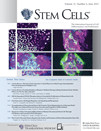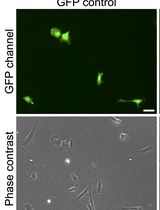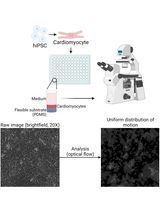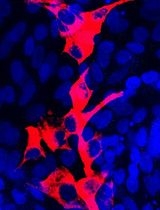- 提交稿件
- 订阅
- CN
- EN - English
- CN - 中文
- EN - English
- CN - 中文
Intestinal Differentiation of Mouse ESCs
小鼠胚胎干细胞在肠道中的分化
发布: 2013年12月20日第3卷第24期 DOI: 10.21769/BioProtoc.1011 浏览次数: 8045
评审: Salma HasanLin FangAnonymous reviewer(s)
Abstract
ES cells (ESCs) are pluripotent and offer a good tool to study early embryonic development. Intestinal cells are derived from the definitive endoderm. In contrast to adult tissue stem cells, embryonic development and differentiation from ES cells have not been as well investigated in the intestine. There are four differentiated cell types of non-proliferative epithelial cells: enterocytes, goblet cells, enteroendocrine cells, and Paneth cells. Intestinal stem cells (ISCs) and progenitor cells reside in crypts, proliferate vigorously, and function as the source of differentiated epithelial cells. Here, we describe a protocol, in which differentiated cell types of the intestine are derived from mouse ESCs. In this protocol, we describe a protocol to differentiate mouse ES cells into Cdx2-expressing intestinal endoderm efficiently by co-culturing with M15, a mouse mesonephric cell line, and treatment with two chemical compounds. The chemical compounds used are BIO and DAPT. BIO is a Gsk3 inhibitor, that activate Wnt signaling pathway, and DAPT is a-secretase inhibitor that inhibit Notch signaling pathway. BIO and DAPT treatment yielded all representative cell lineages, enterocytes, goblet cells, enteroendocrine cells and paneth cells, to be derived from mouse ESCs.
Materials and Reagents
- Mouse embryonic stem cells (ESCs)
- M15 cells (ECACC: catalog number: 95102517 )
- Mouse embryonic fibroblast (MEF)
- 0.1% gelatin
- PBS
- Dulbecco’s Modified Eagle Medium (DMEM) high glucose (Gibco®, catalog number: 11995-075)
- DMEM low glucose (Gibco®, catalog number: 11885-084 )
- Fetal Bovine Serum (FBS) (Hyclone, catalog number: SH30310.03 )
- 200 mM L-glutamine (L-Gln) (Nacalai Tesque, catalog number: 16948-04 )
- 5,000 units/ml mixture of penicillin and streptomycin (PS) (Nacalai Tesque, catalog number: 26252-94 )
- 10 mM MEM Non-Essential Amino Acids Solution (NEAA) (Gibco®, catalog number: 11140-050 )
- 2-mercaptoethanol (2-ME) (Sigma-Aldrich, catalog number: M7522 )
- D-(+)-Glucose (Sigma-Aldrich, catalog number: G5146 )
- KnockOut Serum Replacement (KSR) (Gibco®, catalog number: 10828 )
- Recombinant human LIF (Wako Pure Chemical Industries, catalog number: 129-05601 )
- Recombinant human Activin A (R&D Systems, catalog number: 338-AC )
- Recombinant human bFGF (Pepro Tech, catalog number: 100-18B )
- BIO (Calbiochem®, catalog number: 361550 )
- DAPT (Wako Pure Chemical Industries, catalog number: 041-30983 )
- Mitomycin C (MMC) (Sigma-Aldrich, catalog number: M4287 )
- 0.05% Trypsin-EDTA (Life Technologies, catalog number: 2014-11)
- 0.25% Trypsin-EDTA (Life Technologies, catalog number: 25200-072 )
- EF medium (see Recipes)
- Maintenance Medium (see Recipes)
- EB medium (see Recipes)
- Endoderm Medium (see Recipes)
- Intestinal Medium (see Recipes)
Equipment
- 6 well plate (Corning, catalog number: 3516)
- 100 mm dish (Corning, catalog number: 430167 )
- 60 mm dish (BD Biosciences, Falcon®, catalog number: 353004 )
- Centrifuge
- 37 °C 5% CO2 Cell culture incubator
Procedure
文章信息
版权信息
© 2013 The Authors; exclusive licensee Bio-protocol LLC.
如何引用
Ogaki, S. and Kume, S. (2013). Intestinal Differentiation of Mouse ESCs. Bio-protocol 3(24): e1011. DOI: 10.21769/BioProtoc.1011.
分类
干细胞 > 胚胎干细胞 > 维持和分化
细胞生物学 > 细胞分离和培养 > 细胞分化
您对这篇实验方法有问题吗?
在此处发布您的问题,我们将邀请本文作者来回答。同时,我们会将您的问题发布到Bio-protocol Exchange,以便寻求社区成员的帮助。
提问指南
+ 问题描述
写下详细的问题描述,包括所有有助于他人回答您问题的信息(例如实验过程、条件和相关图像等)。
Share
Bluesky
X
Copy link












